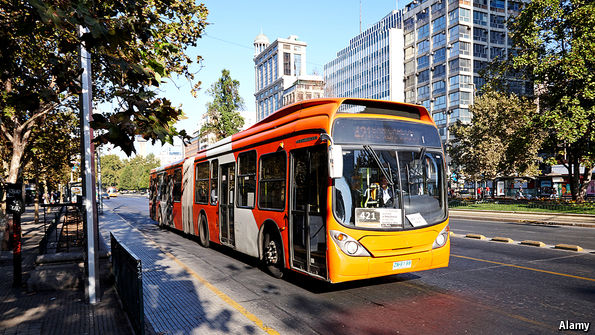Santiago’s transport system is sputtering
Commuters do not want to pay for bad service
TRANSANTIAGO, the Chilean capital’s public-transport system, had its tenth birthday in February, but no one celebrated. Launched with much fanfare, the scheme was supposed to integrate bus and metro lines and speed up traffic. Smog-spewing yellow buses disappeared. Smart cards replaced cash.
But Transantiago is sputtering. Fare evasion is rampant, journeys are getting slower and the state has spent billions of dollars to prop up private bus operators. Passengers sometimes wait ages at stops scrawled with graffiti with no inkling of when the next bus will arrive. Espacio Público, a think-tank, calls Transantiago Chile’s worst public-policy project since the country returned to democracy in 1990.
Despite all that, Transantiago has brought some improvements. The number of fatal accidents has dropped sharply, as has pollution from exhaust fumes. The system’s 20,000 employees are now on formal contracts and have better working conditions than before. Because bus drivers no longer handle cash, the number of robberies has fallen. Compared with transport in many other Latin American cities, Santiago’s works pretty well.
But it would be hard to persuade most commuters of that. The problems start with design. Planners laid some bus lanes directly over metro lines, so the two forms of transport compete rather than complementing each other. The city has hired too few inspectors to catch fare-dodgers and motorists who stray into bus lanes (though cameras are catching some of the errant cars). Sometimes buses are so crowded that even honest passengers have trouble reaching the card-swiper.
Increasingly, passengers are less inclined to pay. Despite the subsidies, fares have risen by 40% since 2010, far faster than most prices. Bus journeys have slowed by 8% since 2012. For some, fare-dodging is a form of protest. Guillermo Muñoz, the metropolitan area’s director of public transport, admits that in some parts of the capital the service is “very bad”. Last month Chile’s transport minister resigned, in part to take responsibility for Transantiago’s failings.
Espacio Público says one reason for the high subsidies is that too few companies operate the buses. The system began with 16 operators but dropouts and mergers have shrunk the number to seven. The largest firms operate 1,200 buses apiece. This makes them “too big to fail”, says Clemente Pérez of Espacio Público. Hence the subsidies to keep money-losing companies afloat. No company should have more than 10% of the market, Mr Pérez thinks.
The city will have a chance to correct that next year, when contracts to operate bus lines are to expire. It is likely to encourage smaller and newer companies to enter the market. That might release money for improvements. The new transport minister, Paola Tapia, has created a task-force to help reduce fare-dodging and promised more money for inspectors. With luck, Transantiago could become a service that commuters are happy to pay for.
But Transantiago is sputtering. Fare evasion is rampant, journeys are getting slower and the state has spent billions of dollars to prop up private bus operators. Passengers sometimes wait ages at stops scrawled with graffiti with no inkling of when the next bus will arrive. Espacio Público, a think-tank, calls Transantiago Chile’s worst public-policy project since the country returned to democracy in 1990.
Latest updates
But it would be hard to persuade most commuters of that. The problems start with design. Planners laid some bus lanes directly over metro lines, so the two forms of transport compete rather than complementing each other. The city has hired too few inspectors to catch fare-dodgers and motorists who stray into bus lanes (though cameras are catching some of the errant cars). Sometimes buses are so crowded that even honest passengers have trouble reaching the card-swiper.
Advertisement: Replay Ad
|
Espacio Público says one reason for the high subsidies is that too few companies operate the buses. The system began with 16 operators but dropouts and mergers have shrunk the number to seven. The largest firms operate 1,200 buses apiece. This makes them “too big to fail”, says Clemente Pérez of Espacio Público. Hence the subsidies to keep money-losing companies afloat. No company should have more than 10% of the market, Mr Pérez thinks.
The city will have a chance to correct that next year, when contracts to operate bus lines are to expire. It is likely to encourage smaller and newer companies to enter the market. That might release money for improvements. The new transport minister, Paola Tapia, has created a task-force to help reduce fare-dodging and promised more money for inspectors. With luck, Transantiago could become a service that commuters are happy to pay for.

No comments:
Post a Comment